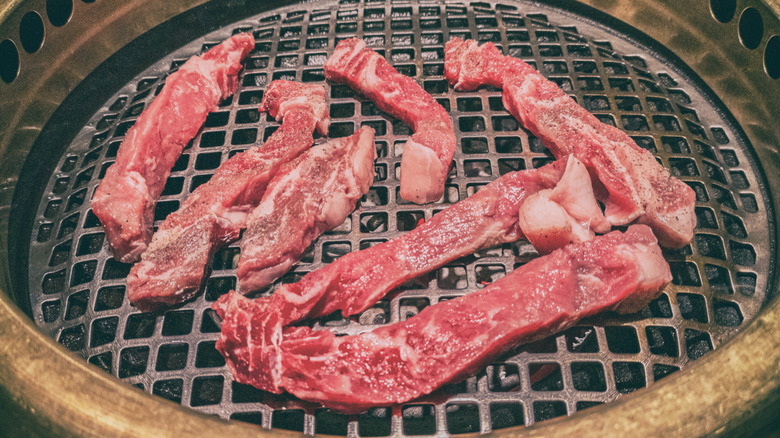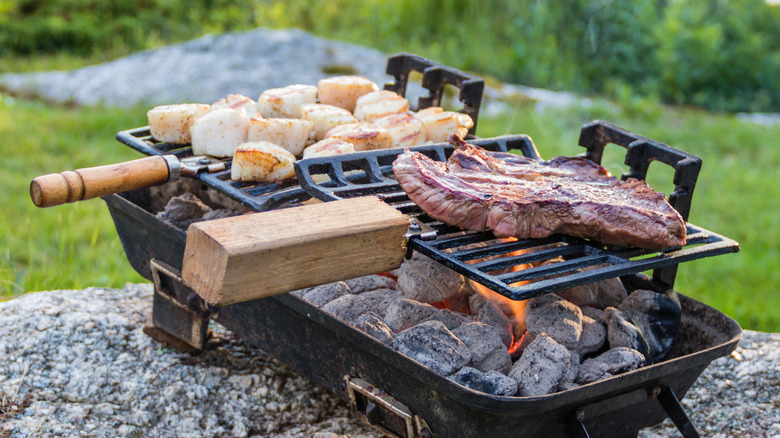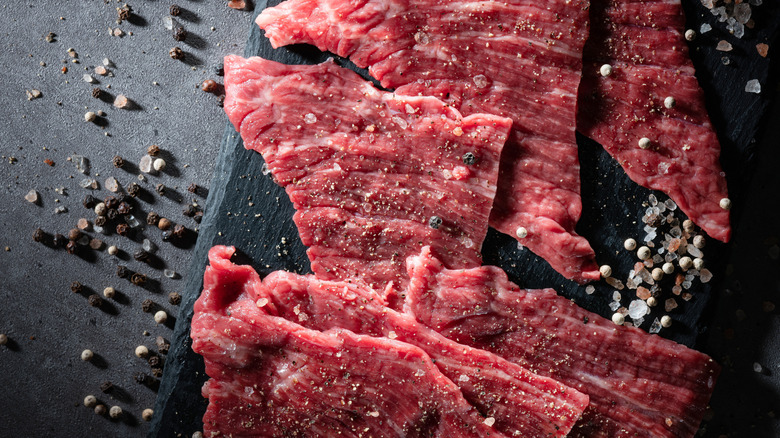The Absolute Best Cut Of Steak To Use For Hibachi
In the West, when people talk about hibachi, they're usually referring to a theatrical, table-side experience where the chefs cook sizzling meats before your eyes. But in Japan, traditional Japanese hibachi cooking is quite different — it involves grilling over high-heat, open-flame charcoal grills. So, when it comes to cooking traditional hibachi-style steak, which cut works best? To find out, Food Republic consulted expert Namiko Hirasawa Chen, founder of Just One Cookbook and JOC Goods. Her recommendation? Go with tenderloin.
"When grilling steak [on a hibachi], it's not just about tenderness or marbling[;] it's about how the meat handles open flame and intense heat," Chen explained. In other words, it's not necessarily the most luxurious or well-marbled steak that performs best. What matters is if it can handle the heat. Take ribeye, a prized cut of steak for its rich flavor and tenderness. While it might seem like a sensible choice, Chen told us that these qualities don't immediately guarantee top results on a hibachi grill: "Fatty cuts like ribeye are less commonly used for charcoal grilling because the fat renders quickly and can cause flare-ups." So features that make ribeye desirable in a pan can actually be a detriment on a hibachi, causing charring and uneven cooking when exposed to open flames. Instead, Chen recommended using tenderloin. Its natural tenderness and smaller amount of fat make it the ideal choice for hibachi cooking: "The result is a steak with great texture and even doneness, without the risk of charring from dripping fat," Chen noted.
Budget-friendly cuts you can use for hibachi at home
Tenderloin is an expensive cut (although you can get it for a bargain at Costco), so if you're looking to do hibachi-style on a budget, Namiko Hirasawa Chen advised us on what to look out for: "The key with hibachi-style grilling is quick, even cooking, so you want cuts that are relatively lean, tender, and not too thick." Open flame doesn't allow for precise temperature control. This means the best cuts are those that can evenly cook in a short amount of time without charring or drying out.
There are several underrated cuts of steak for grilling. "If tenderloin isn't available, New York strip and sirloin are great alternatives. Both offer good flavor and hold up well to fast grilling," Chen told us. They're more affordable than tenderloin. Compared to fattier cuts like ribeye, these steaks have less marbling and external fat, reducing flare-ups and lowering the risk of charring. New York strip offers a moderate amount of marbling, which contributes to its rich flavor and keeps it moist as it cooks. Sirlion is leaner, but still provides a satisfying balance of tenderness and beefy flavor.
As for what to avoid, Chen advised us: "Just avoid tougher cuts that need long, slow cooking to break down, like brisket or chuck." While these cuts are top choices for braising and smoking, they perform terribly when the goal is high heat, fast cooking. On a hibachi grill, they're likely to end up undercooked with a charred, inedible crust.
How to prepare hibachi-style steaks
When grilling hibachi-style steak, the technique is just as important as the cut you use. Namiko Hirasawa Chen recommended: "Slice the meat into evenly sized pieces, about ⅜ inch thick, so they cook quickly and consistently." If the cuts are too thick, you run the risk of a burnt exterior and an undercooked center. Keep cooking short but sweet. Get the heat high and don't go more than three or so minutes per side unless you want your steak well done.
While sauces are great pairings for hibachi-style steak, there's one crucial rule. "I don't recommend marinating beforehand, as sugars and sauces can burn easily over hot coals," Chen told us. When sugar is exposed to high heat, it caramelizes. This is delicious in moderation, but when the heat is too high, it can leave behind a sticky and bitter residue, which will ruin the texture and flavor of your steak. Instead, wait until the steak is nearly finished before adding your sauce, as Chen recommended: "Once [the steak is] nearly done, brush on a flavorful sauce to add depth and smokiness without risking burnt flavors." Classic hibachi sauces include soy sauce, ginger sauce, and Yum Yum sauce, a creamy condiment made from mayo, ketchup, melted butter, garlic powder, sugar, paprika, and vinegar – all ideal for dipping and adding an extra layer of flavor to your steak.



